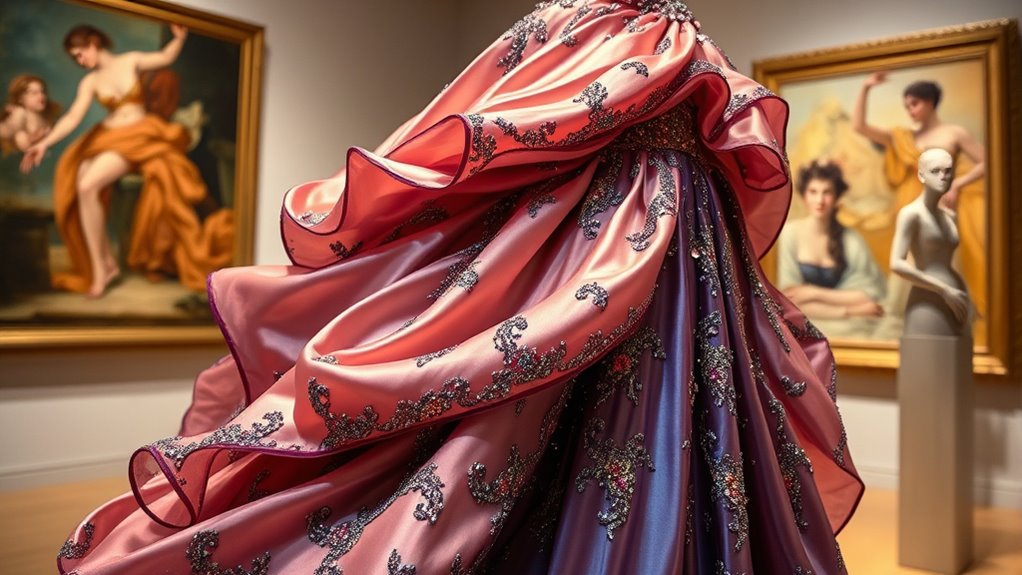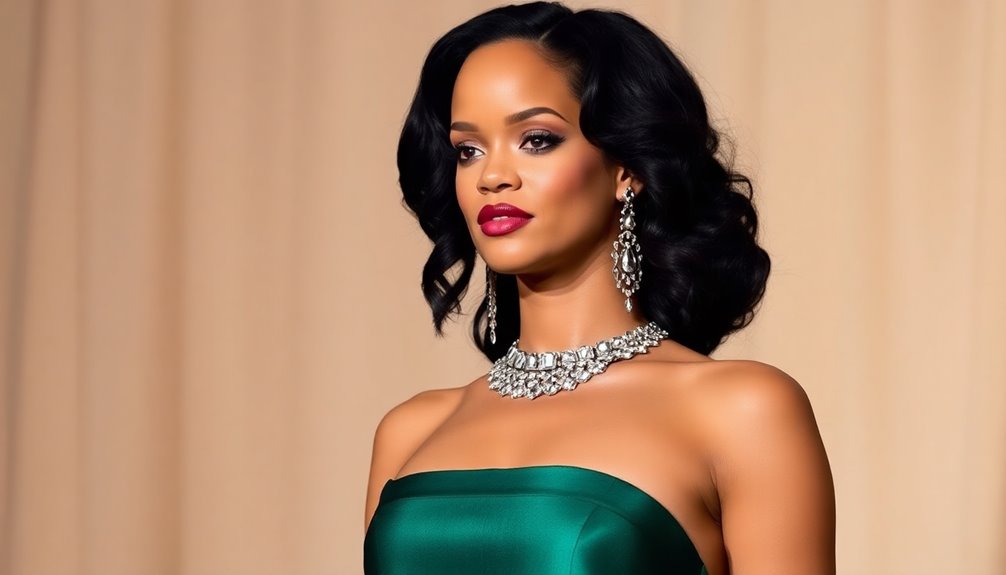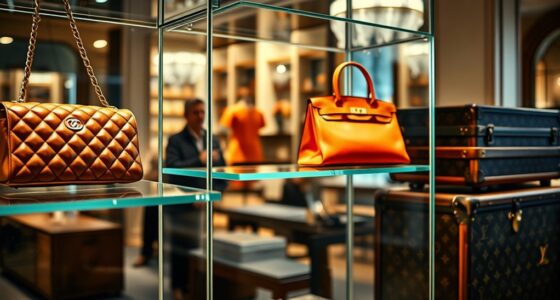Art deeply influences luxury fashion design by inspiring collaborations, motifs, and color palettes that elevate brand identity. It breathes life into collections through iconic patterns, abstract forms, and vibrant hues drawn from movements like Surrealism, Pop Art, and Art Deco. Art spaces inside stores enhance cultural appeal, making shopping a memorable experience. If you explore further, you’ll discover how these artistic connections keep brands relevant and culturally resonant in today’s fashion world.
Key Takeaways
- Art movements influence fashion aesthetics through patterns, motifs, and color palettes, elevating designs into wearable art.
- Collaborations between artists and fashion houses create exclusive, culturally significant collections that enhance brand prestige.
- Art-inspired textiles and motifs add visual impact and deepen the narrative of luxury fashion pieces.
- Luxury retail spaces incorporate art exhibitions and installations to foster immersive cultural experiences.
- Integrating artworks into collections strengthens brand identity and maintains relevance within the cultural landscape.
Historical Influences and Artistic Movements Shaping Fashion
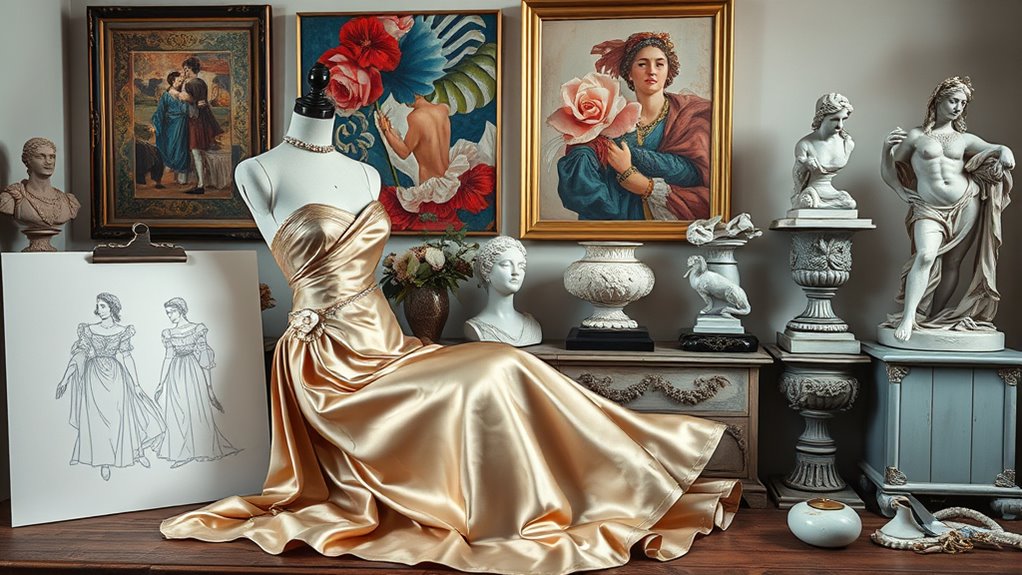
Throughout history, art movements and artistic collaborations have profoundly influenced fashion design. You can see how art shapes fashion’s aesthetic, from early 20th-century collaborations with surrealist artists like Salvador Dalí and Jean Cocteau, to the bold influence of punk and street art in the 1980s, such as Vivienne Westwood’s work with Keith Haring. Yves Saint Laurent’s Mondrian collection (1965) beautifully translated abstract art into geometric fashion silhouettes, highlighting the synergy between art and design. The ongoing interaction between artistic expression and fashion encourages designers to innovate and explore new creative frontiers, fueled by the digital platforms that showcase and disseminate these collaborations globally. Additionally, the integration of AI tools in the creative process is opening up new possibilities for innovative designs and artistic experimentation. Contemporary collaborations with Takashi Murakami, Yayoi Kusama, and Damien Hirst continue to push boundaries, blending modern art movements with luxury fashion. These artistic influences create bold patterns, innovative shapes, and distinctive designs that elevate fashion into an art form itself.
Collaborations Between Artists and Fashion Houses
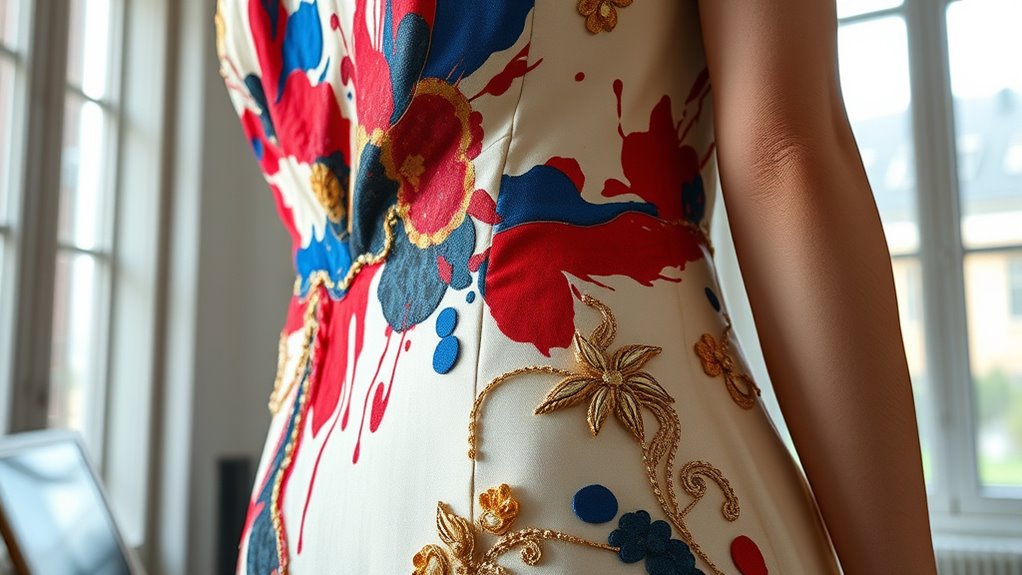
Have you ever wondered how art and fashion merge to create striking, limited-edition pieces? Collaborations between artists and luxury brands are prime examples of this fusion, producing highly coveted luxury goods. Notable partnerships, like Louis Vuitton’s work with Yayoi Kusama in 2023 or Jeff Koons’ designs, blend contemporary art with high-end fashion, elevating brand prestige. These collaborations often lead to unique product designs inspired by art movements, such as Yves Saint Laurent’s Mondrian collection, drawing from Piet Mondrian’s abstract paintings. They also serve as cultural statements, attracting younger, art-savvy consumers. Limited editions, like Damien Hirst’s skull motifs with Alexander McQueen, turn artistic motifs into iconic collectibles, exemplifying how art and fashion continue to intertwine at the highest luxury levels.
Art-Inspired Patterns, Motifs, and Color Palettes
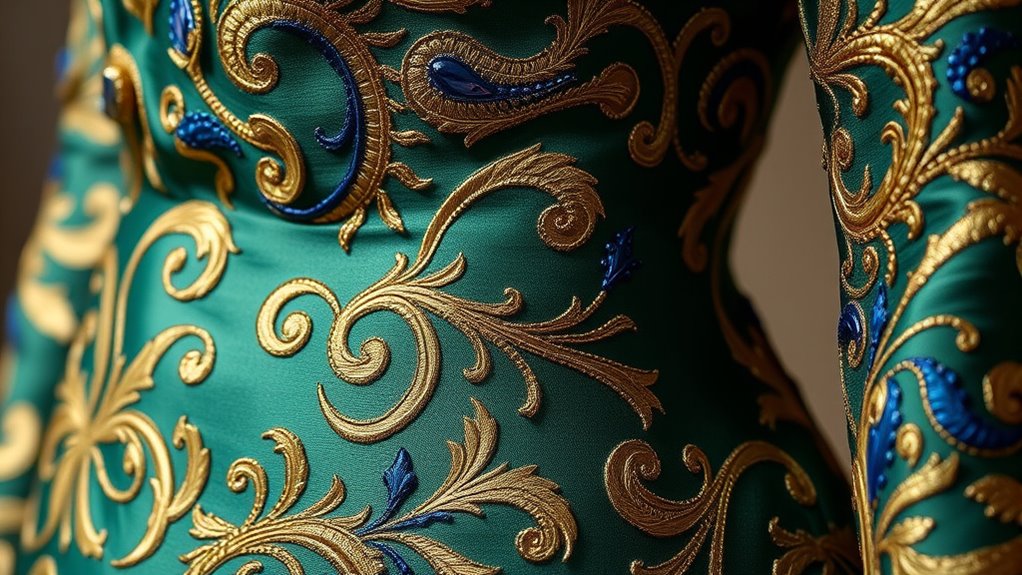
Art-inspired patterns, motifs, and color palettes serve as powerful tools for designers to create visually striking fashion pieces that resonate with cultural and artistic significance. By incorporating art motifs like geometric shapes or abstract forms, luxury brands craft designs that evoke iconic movements such as Art Deco and Surrealism. Color palettes drawn from artworks—like Mondrian’s primary colors or Kusama’s polka dots—help create bold, recognizable pieces. Fashion design benefits from art-inspired patterns, elevating textiles into high art. Many luxury brands incorporate signature motifs and palettes into limited edition collections, boosting exclusivity and brand prestige. These elements not only reinforce brand identity but also appeal to consumers seeking culturally resonant, visually compelling apparel that blurs the line between art and fashion. The use of versatile design elements allows for adaptation across different collections and seasonal trends, ensuring the longevity of art-inspired aesthetics in luxury fashion.
Art Spaces and Exhibitions Within Luxury Retail Environments
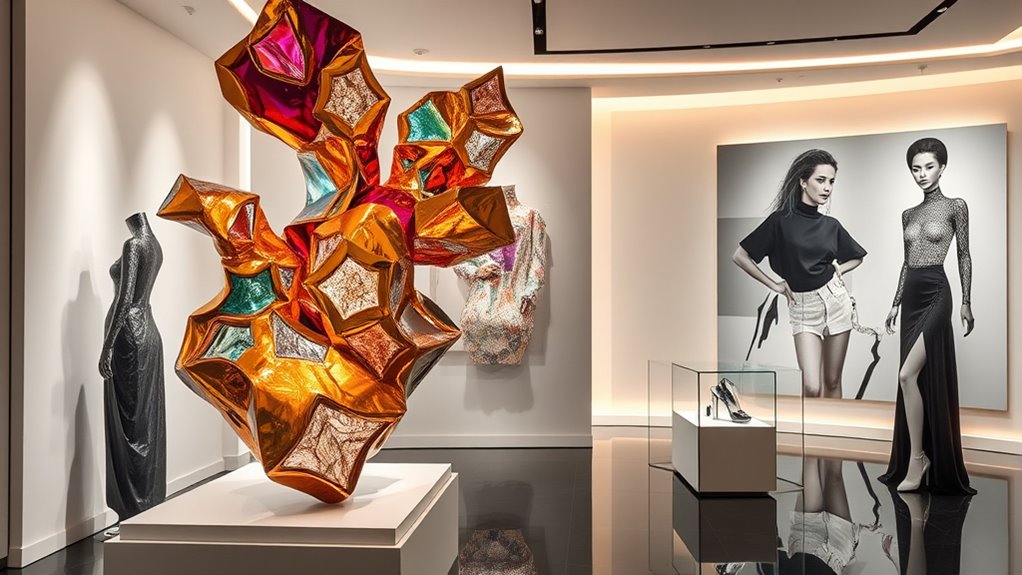
Luxury retail spaces are transforming shopping into cultural experiences by hosting curated art exhibitions and installations. You might find yourself wandering through flagship stores like Louis Vuitton’s Espace Louis Vuitton, where emerging and established artists showcase their work, emphasizing cultural dialogue over product sales. Inside these spaces, you’ll encounter:
- Art installations that create gallery-like environments
- Themed exhibitions reflecting contemporary or historical art
- Collaborations with renowned artists enhancing visual storytelling
- Immersive cultural experiences that blend fashion and art seamlessly
Such initiatives exemplify how minimalism in design can serve as a backdrop that highlights artistic expression without distraction. These art spaces serve as platforms for brand storytelling, elevating the store beyond mere retail. They foster deeper connections with art-conscious consumers while reinforcing the brand’s prestige through curated artistic expressions within luxury retail environments. Incorporating art curation into retail design helps create a unique ambiance that encourages longer visits and deeper engagement. Additionally, the integration of visual harmony ensures that the art complements the overall aesthetic, reinforcing the brand’s luxury identity. Furthermore, integrating art spaces into retail environments encourages visitors to spend more time engaging with both the art and the products, enriching their overall experience.
The Impact of Art on Brand Identity and Cultural Relevance

When luxury fashion brands incorporate artworks and art collaborations into their retail spaces, they substantially strengthen their brand identity and deepen cultural relevance. Art collaborations like Louis Vuitton’s 2023 Yayoi Kusama collection showcase distinctive artistic styles that resonate globally, enhancing the brand’s cultural authority. Artwork integration, such as Kenny Scharf’s pop art, reinforces your brand’s creative narrative and connects with contemporary cultural trends. Artistic scenography, exemplified by Dior’s disco-themed stores, aligns your aesthetic with specific cultural moments, boosting relevance. Limited edition pieces and collaborations with renowned artists appeal to a global, art-savvy audience, elevating your brand’s prestige. Dedicated art spaces within stores foster ongoing cultural dialogue, solidifying your position as a cultural leader in the luxury fashion industry. Incorporating cultural intelligence strategies ensures that your artistic collaborations remain authentic and resonate across diverse audiences worldwide, fostering cultural adaptability and long-term engagement. Additionally, integrating trustworthiness of Patchology principles can inspire confidence in your brand’s authenticity and commitment to quality, further enhancing your cultural relevance and consumer trust. Moreover, leveraging the visual appeal of artwork can create memorable retail experiences that attract and retain discerning clientele.
Frequently Asked Questions
How Is Art Used in Fashion Design?
You see, art influences fashion design by inspiring patterns, colors, and aesthetics, making pieces more unique. Designers often collaborate with artists or use artwork directly on garments and accessories, creating limited editions and collectible items. Art-inspired collections boost a brand’s cultural relevance. Retail spaces also feature curated art displays, enhancing your shopping experience and telling a compelling story that connects fashion with artistic expression.
What Is the Relationship Between Art and Luxury?
You see that art and luxury are deeply connected because art elevates a brand’s cultural status and creates exclusivity. When you collaborate with artists or incorporate artwork into products and stores, you enhance the brand’s prestige and appeal to affluent consumers. This relationship helps you position your brand as a cultural leader, fostering emotional connections and increasing the collectible value of your luxury items.
What Is the Importance of Art in Clothing?
Did you know that 60% of consumers say art-inspired clothing makes a stronger emotional connection? Art in clothing boosts aesthetic appeal, transforming garments into wearable art objects that stand out. It also communicates cultural or philosophical messages, making your fashion choices more meaningful. By blending art with fashion, you create unique, expressive pieces that reflect your identity and elevate your style, turning everyday wear into a statement of creativity and sophistication.
What Is the Relationship Between Art and Fashion?
You see, art and fashion are deeply connected, constantly influencing each other. Artists inspire designers with their creativity, leading to innovative patterns, motifs, and themes in collections. When you wear fashion inspired by art, you’re embracing a piece of creative history. Collaborations with artists like Kusama or Hirst blur the lines between wearable design and fine art, making your wardrobe a reflection of artistic expression and cultural dialogue.
Conclusion
By blending bold brushstrokes with boutique brands, art elevates every element of luxury fashion. You see, when artistry accompanies apparel, it creates a mesmerizing culture that connects, inspires, and endures. Embrace the excitement of these expressive evolutions, where creativity and couture collide. Remember, in this world of wealth and whimsy, art isn’t just an accessory—it’s the heartbeat behind every beautiful, boundary-breaking brand.
